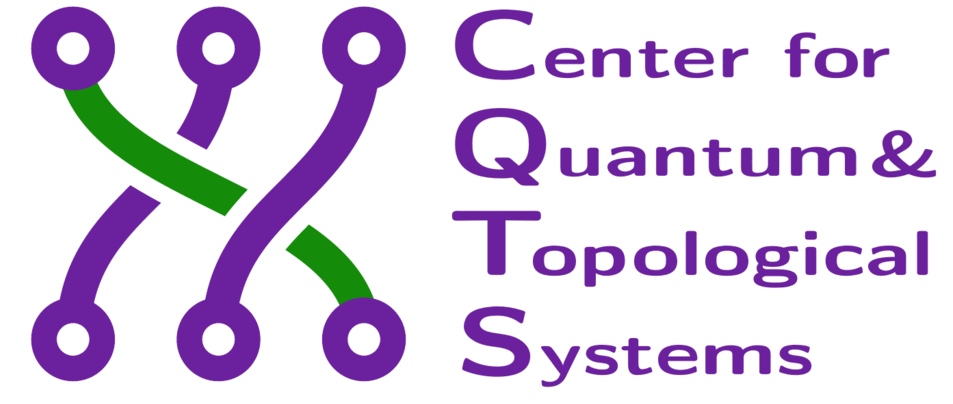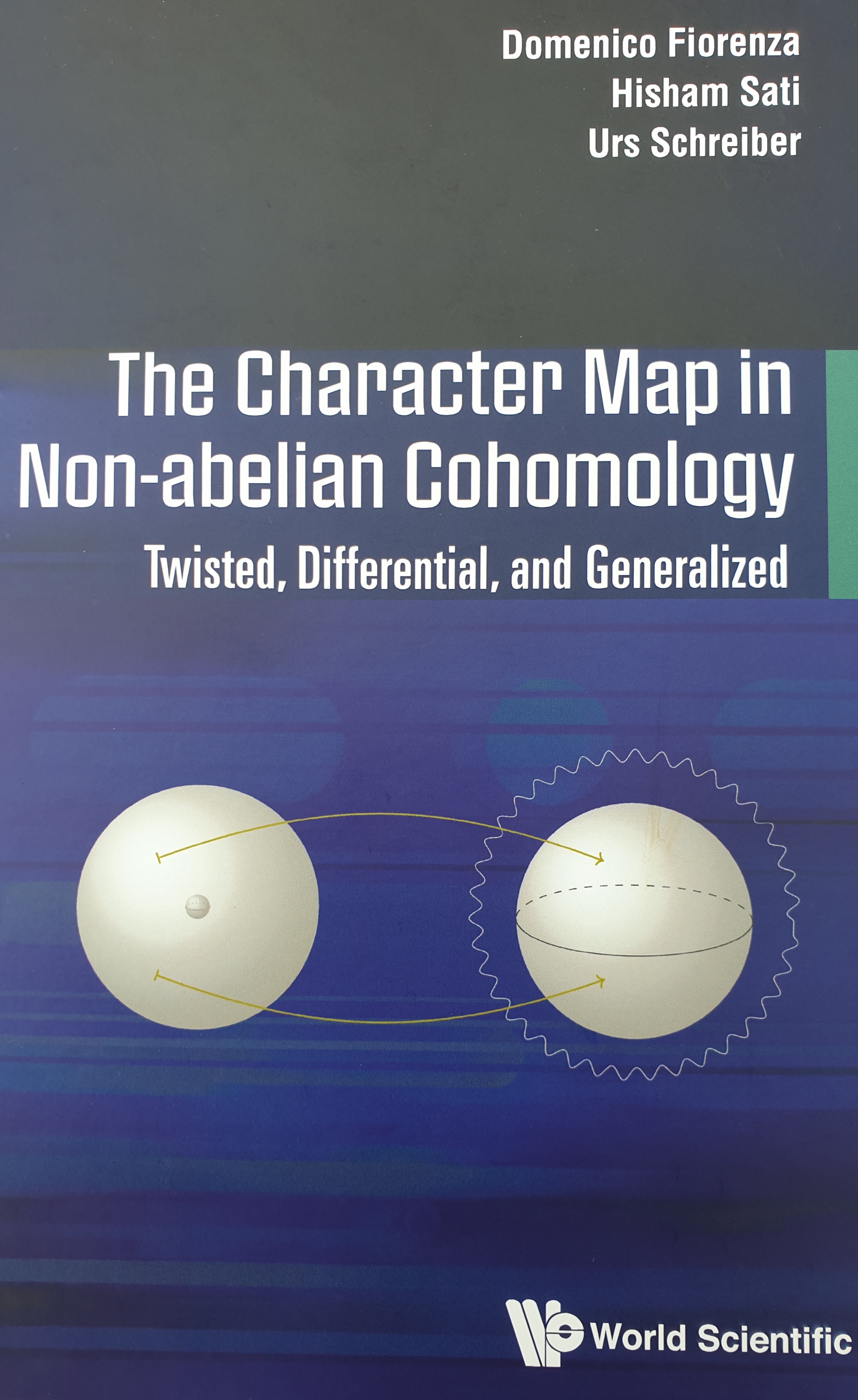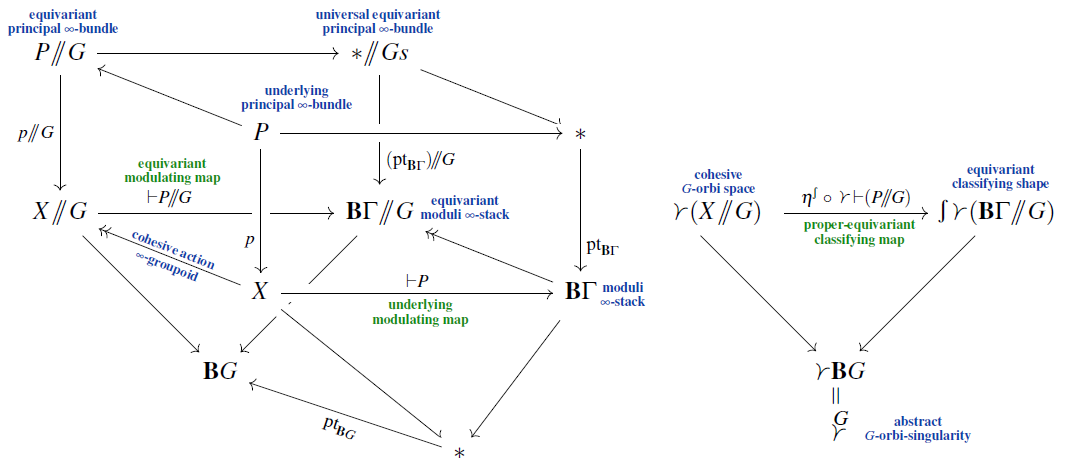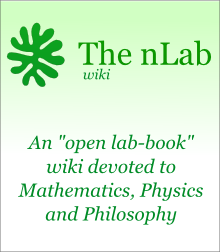nLab Urs Schreiber

contents
position
I work in
the Mathematics Division of Science
of New York University in Abu Dhabi
in the group of Prof. Hisham Sati leading the
Research Center for Quantum and Topological Systems
(see at CQTS for latest activity).
contact
research
I am researching mathematical and fundamental quantum physics, with a focus on using tools of algebraic topology and geometric homotopy theory for understanding elusive strongly-coupled quantum systems with applications to future topological quantum technology.
Projects:
selected talks
For the complete list of invited talks I have given, see there.
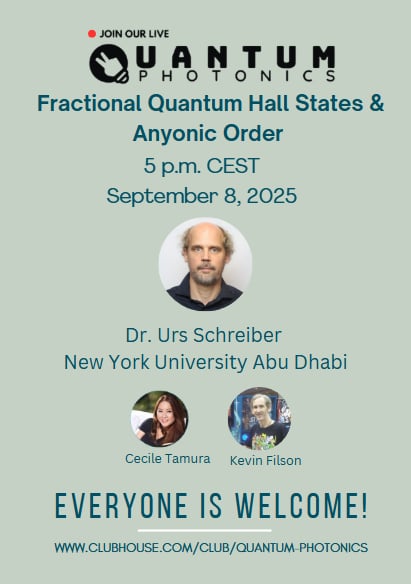
-
Fractional Quantum Anomalous Hall States Anyonic Order
guest appeareance on Quantum Photonics Clubhouse (8 Sep 2025)
-
Identifying Anyonic Topological Order in Fractional Quantum Anomalous Hall Systems
talk at QMATH16, Munich (1-5 Sep 2025)
-
Non-Lagrangian construction of abelian CS/FQH-Theory via Flux Quantization in 2-Cohomotopy
talk at: ISQS29, Prague (7-11 July 2025)
-
Geometric Orbifold Cohomology in Singular-Cohesive ∞-Topoi
talk at ItaCa Fest 2025 (17 June 2025)
slides: pdf
-
Rethinking Topological Quantum
lightning talk at AI & Evolution Gathering by Softmax @ The Royal Institution London (22 May 2025)
video: YT
-
talk at: NYU-NYUAD Workshop on Quantum Matter and Quantum Computing, NYU New York (20 May 2025)
-
guest appearance on Theories of Everything with Curt Jaimungal, 8 March 2025
video: YT
-
Quantum Language via Linear Homotopy Types
mini-course at: IX International Workshop on Information Geometry, Quantum Mechanics and Applications 2025, ICMAT Madrid 24-28 Feb 2025
videos: YT
-
Super-Exceptional Geometry for 11D Supergravity
talk in: HEP seminar @ MPI for Gravitational Physics (Dec 2024)
video: YT
-
Higher Topos Theory in Physics
talk in: Zulip Category Theory Seminar (Jun 2024)
video: YT
-
Towards Certified Topological Quantum Programming via Linear Homotopy Types
talk at: Quantum Information and Quantum Matter 2024, NYUAD (May 2024)
-
Topological Quantum Programming with Linear Homotopy Types
talk at: Homotopy Type Theory Electronic Seminar,, 02 Feb 2024
video: YT
-
Introduction to Quantum Hypothesis H
talk at: M-Theory and Mathematics 2024, Jan 2024
video: kt
-
Higher Topos Theory in Physics
talk at: Wolfram Science Winter School, Jan 2024
video: YT
-
Topological Quantum Gates in Homotopy Type Theory
talk at: QFT and Cobordism 2023
video: YT
-
Higher Topos Theory in Physics
talk at: Workshop on Homotopy Theory and Applications
video: YT
-
Topological Quantum Gates from M-Theory
talk at: M-Theory and Mathematics 2023
video: YT
-
Topological Quantum Programming in TED-K
video: YT
publications:
For comprehensive lists see:
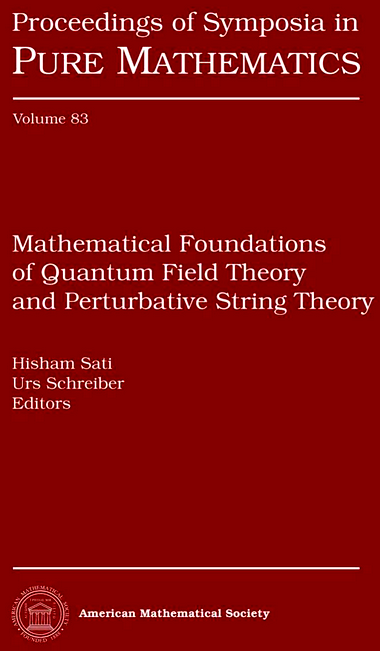
Book collection:
-
Mathematical Foundations of Quantum Field and Perturbative String Theory
(with H. Sati)
Proceedings of Symposia in Pure Mathematics 83
American Mathematical Society (2011)
Cover blurb: Conceptual progress in fundamental theoretical physics is linked with the search for the suitable mathematical structures that model the physical systems. Quantum field theory (QFT) has proven to be a rich source of ideas for mathematics for a long time. However, fundamental questions such as “What is a QFT?” did not have satisfactory mathematical answers, especially on spaces with arbitrary topology, fundamental for the formulation of perturbative string theory.
This book contains a collection of papers highlighting the mathematical foundations of QFT and its relevance to perturbative string theory as well as the deep techniques that have been emerging in the last few years.
The papers are organized under three main chapters: Foundations for Quantum Field Theory, Quantization of Field Theories, and Two-Dimensional Quantum Field Theories. An introduction, written by the editors, provides an overview of the main underlying themes that bind together the papers in the volume.
Monographs:
-
The Character Map in Non-Abelian Cohomology
(with D. Fiorenza & H. Sati)
World Scientific (2023)
Cover blurb: This book presents a novel development of fundamental and fascinating aspects of algebraic topology and mathematical physics: “extra-ordinary” and further generalized cohomology theories enhanced to “twisted” and differential-geometric form with focus on their rational approximation by generalized Chern character maps and on the resulting charge quantization laws in higher -form gauge field theories appearing in string theory and in the classification of topological quantum materials.
Motivation for the conceptual re-development is the observation, laid out in the introductory chapter, that famous and famously elusive effects in strongly interacting (“non-perturbative”) physics demand “non-abelian” generalization of much of established generalized cohomology theory. But the relevant higher non-abelian cohomology theory (”higher gerbes“) has an esoteric reputation and has remained underdeveloped.
The book’s theme is that variously generalized cohomology theories are best viewed through their classifying spaces – possibly but not necessarily infinite-loop spaces – from which perspective the character map is really an incarnation of the fundamental theorem of rational homotopy theory, thereby uniformly subsuming not only the classical Chern character and a multitude of scattered variants that have been proposed, but now seamlessly applying in the previously elusive generality of (twisted, differential and) non-abelian cohomology.
In laying out this result with plenty of examples, we provide modernized introduction and review of fundamental classical topics: 1. abstract homotopy theory via model categories, 2. generalized cohomology in homotopical incarnation, 3. dg-algebraic rational homotopy theory, whose fundamental theorem we re-cast as a (twisted) non-abelian de Rham theorem which naturally induces the (twisted) non-abelian character map.
-
Equivariant Principal -Bundles
(with H. Sati)
Cambridge University Press
(2025, in print)
-
further monographs on the nLab:
-
other:
-
Higher Prequantum Geometry, in: New Spaces for Mathematics and Physics, Cambr. Univ. Press (2021) doi:10.1017/9781108854429
-
Mathematical Foundations of Quantum Field and Perturbative String Theory, Proceedings of Symposia in Pure Mathematics 83 Amer. Math. Soc (2011) ISBN:978-0-8218-5195-1
-
research wiki
For making notes on math/phys I had started (in Nov 2008)
with edit logs and discussion being had on:
For more on the Lab, see:
-
me on: What is… the nLab?
(presentation at: Big Data in Pure Mathematics 2022)
-
Wikipedia on: nLab.
more web logs
For logs of further activity see:
-
my feed at X/Twitter (new)
-
my old feed at X/Twitter (lost my password…)
while Lab-edits are announced
For links to technical discussions about math and physics see my pages:
teaching
See behind these links for lecture notes that I wrote:
| date | lecture notes |
|---|---|
| winter 2017 | Mathematical Quantum Field Theory |
| summer 2017 | Topological K-Theory |
| summer 2017 | Topology |
| winter 2016 | Super Cartan Geometry |
| summer 2016 | Complex oriented cohomology theory |
| summer 2016 | Stable Homotopy Theory |
| summer 2015 | Structure Theory for Higher WZW Terms |
| summer 2015 | Higher Cartan Geometry |
| summer 2014 | Homological Algebra |
A list of further teaching in the past is here.
column
I used to write an irregular column at PhysicsForums Insights. Articles in the series include these:
on pre-quantum field theory
-
Higher prequantum geometry I: The need for prequantum geometry
-
Higher prequantum geometry II: The principle of extremal action – Comonadically
-
Higher prequantum geometry III: The global action functional – Cohomologically
-
Higher prequantum geometry IV: The covariant phase space – Transgressively
-
Higher prequantum geometry V: The local observables – Lie theoretically
-
Examples of Prequantum field theories II: Higher gauge fields
-
Examples of Prequantum field theories III: Chern-Simons-type theories
-
Examples of Prequantum field theories IV: Wess-Zumino-Witten-type theories
on perturbative quantum field theory
on string theory
joining our research
If you are a graduate student or young postdoc thinking of entering the Sati-Schreiber program, here is some basic reading to start with:
-
for relevant basics of general homotopy theory and -stacks/smooth -groupoids:
see the chapter Model categories in The Character Map in Non-Abelian Cohomology (chapter 1 in the printed version, appendix in the arXiv version)
and for more details the nLab entries Introduction to Homotopy Theory or for yet more details geometry of physics – categories and toposes
-
for relevant basics of rational homotopy theory and -Lie algebras:
see the part Non-abelian de Rham cohomology in The Character Map in Non-Abelian Cohomology
-
for relevant basics of supergravity and super -branes:
see the articles Flux Quantization on 11d Superspace and Flux Quantization on M5-Branes
and/or the nLab entry geometry of physics – supergeometry and superphysics
copyright statement
To the extent that it matters, my contributions to the nLab are copyrighted according to CC BY-SA 3.0.
Last revised on September 8, 2025 at 13:49:29. See the history of this page for a list of all contributions to it.
